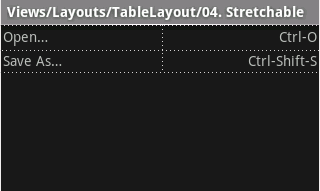TableLayout is a ViewGroup that
displays child View elements in rows and columns.

TableLayout positions its children into rows
and columns. TableLayout containers do not display border lines for their rows, columns,
or cells. The table will have as many columns as the row with the most cells. A table can leave
cells empty, but cells cannot span columns, as they can in HTML.
TableRow objects are the child views of a TableLayout
(each TableRow defines a single row in the table).
Each row has zero or more cells, each of which is defined by any kind of other View. So, the cells of a row may be
composed of a variety of View objects, like ImageView or TextView objects.
A cell may also be a ViewGroup object (for example, you can nest another TableLayout as a cell).
The following sample layout has two rows and two cells in each. The accompanying screenshot shows the result, with cell borders displayed as dotted lines (added for visual effect).
<?xml version="1.0" encoding="utf-8"?>
<TableLayout xmlns:android="http://schemas.android.com/apk/res/android"
android:layout_width="fill_parent"
android:layout_height="fill_parent"
android:stretchColumns="1">
<TableRow>
<TextView
android:text="@string/table_layout_4_open"
android:padding="3dip" />
<TextView
android:text="@string/table_layout_4_open_shortcut"
android:gravity="right"
android:padding="3dip" />
</TableRow>
<TableRow>
<TextView
android:text="@string/table_layout_4_save"
android:padding="3dip" />
<TextView
android:text="@string/table_layout_4_save_shortcut"
android:gravity="right"
android:padding="3dip" />
</TableRow>
</TableLayout>
|
 |
Columns can be hidden, marked to stretch and fill the available screen space,
or can be marked as shrinkable to force the column to shrink until the table
fits the screen. See the TableLayout reference
documentation for more details.
Example
- Start a new project named HelloTableLayout.
- Open the
res/layout/main.xmlfile and insert the following:<?xml version="1.0" encoding="utf-8"?> <TableLayout xmlns:android="http://schemas.android.com/apk/res/android" android:layout_width="fill_parent" android:layout_height="fill_parent" android:stretchColumns="1"> <TableRow> <TextView android:layout_column="1" android:text="Open..." android:padding="3dip" /> <TextView android:text="Ctrl-O" android:gravity="right" android:padding="3dip" /> </TableRow> <TableRow> <TextView android:layout_column="1" android:text="Save..." android:padding="3dip" /> <TextView android:text="Ctrl-S" android:gravity="right" android:padding="3dip" /> </TableRow> <TableRow> <TextView android:layout_column="1" android:text="Save As..." android:padding="3dip" /> <TextView android:text="Ctrl-Shift-S" android:gravity="right" android:padding="3dip" /> </TableRow> <View android:layout_height="2dip" android:background="#FF909090" /> <TableRow> <TextView android:text="X" android:padding="3dip" /> <TextView android:text="Import..." android:padding="3dip" /> </TableRow> <TableRow> <TextView android:text="X" android:padding="3dip" /> <TextView android:text="Export..." android:padding="3dip" /> <TextView android:text="Ctrl-E" android:gravity="right" android:padding="3dip" /> </TableRow> <View android:layout_height="2dip" android:background="#FF909090" /> <TableRow> <TextView android:layout_column="1" android:text="Quit" android:padding="3dip" /> </TableRow> </TableLayout>Notice how this resembles the structure of an HTML table. The
TableLayoutelement is like the HTML<table>element;TableRowis like a><tr>>element; but for the cells, you can use any kind ofViewelement. In this example, aTextViewis used for each cell. In between some of the rows, there is also a basicView, which is used to draw a horizontal line. - Make sure your HelloTableLayout Activity loads this layout in the
onCreate()method:public void onCreate(Bundle savedInstanceState) { super.onCreate(savedInstanceState); setContentView(R.layout.main); }The
setContentView(int)method loads the layout file for theActivity, specified by the resource ID —R.layout.mainrefers to theres/layout/main.xmllayout file. - Run the application.
You should see the following:
